MGT5STR Strategic Management Report: Namoi Cotton Limited Analysis
VerifiedAdded on 2022/11/03
|9
|2197
|341
Report
AI Summary
This report provides a strategic analysis of Namoi Cotton Limited, a fully integrated marketing, shipping, warehousing, and ginning company in the Australian fibre-focused agribusiness sector. The report begins with an introduction to the company, outlining its operations and strategic initiatives. It then delves into the company's strengths, weaknesses, opportunities, and threats, followed by recommendations for future strategic direction, including business-level strategies related to expansion, contraction, and maintenance. The report emphasizes the importance of a progressive pricing policy, unique product strategy, and effective distribution channels. An implementation plan is presented, focusing on innovation, technology adoption, and employee training. The evaluation strategy includes benchmarks for operational performance, methods for measuring performance, and determining variances. Finally, the report concludes with a summary of key findings and recommendations, emphasizing the need for adaptation and diversification to meet the challenges of the competitive market. The report also adheres to academic writing guidelines with a structured format and references.
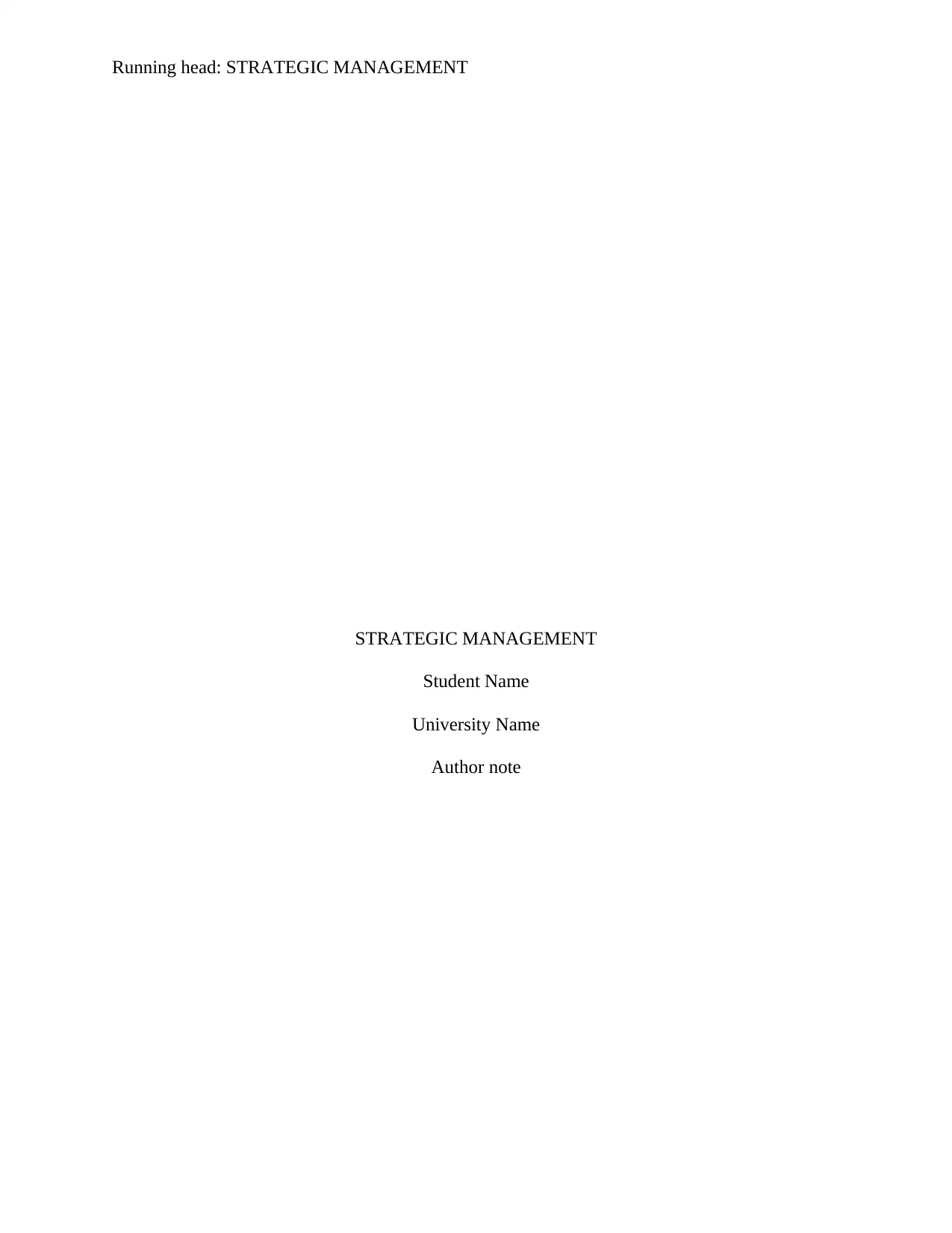
Running head: STRATEGIC MANAGEMENT
STRATEGIC MANAGEMENT
Student Name
University Name
Author note
STRATEGIC MANAGEMENT
Student Name
University Name
Author note
Paraphrase This Document
Need a fresh take? Get an instant paraphrase of this document with our AI Paraphraser
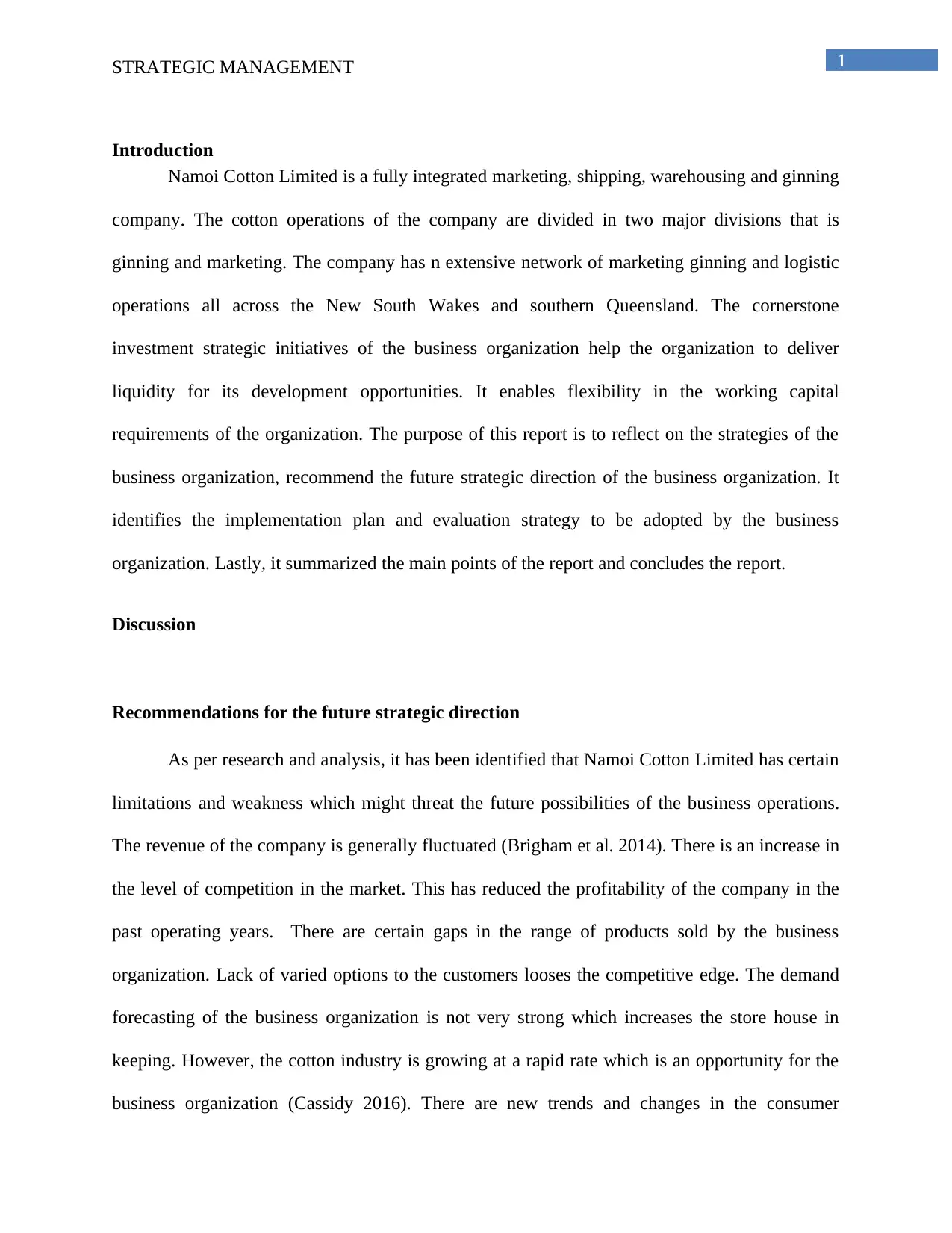
1STRATEGIC MANAGEMENT
Introduction
Namoi Cotton Limited is a fully integrated marketing, shipping, warehousing and ginning
company. The cotton operations of the company are divided in two major divisions that is
ginning and marketing. The company has n extensive network of marketing ginning and logistic
operations all across the New South Wakes and southern Queensland. The cornerstone
investment strategic initiatives of the business organization help the organization to deliver
liquidity for its development opportunities. It enables flexibility in the working capital
requirements of the organization. The purpose of this report is to reflect on the strategies of the
business organization, recommend the future strategic direction of the business organization. It
identifies the implementation plan and evaluation strategy to be adopted by the business
organization. Lastly, it summarized the main points of the report and concludes the report.
Discussion
Recommendations for the future strategic direction
As per research and analysis, it has been identified that Namoi Cotton Limited has certain
limitations and weakness which might threat the future possibilities of the business operations.
The revenue of the company is generally fluctuated (Brigham et al. 2014). There is an increase in
the level of competition in the market. This has reduced the profitability of the company in the
past operating years. There are certain gaps in the range of products sold by the business
organization. Lack of varied options to the customers looses the competitive edge. The demand
forecasting of the business organization is not very strong which increases the store house in
keeping. However, the cotton industry is growing at a rapid rate which is an opportunity for the
business organization (Cassidy 2016). There are new trends and changes in the consumer
Introduction
Namoi Cotton Limited is a fully integrated marketing, shipping, warehousing and ginning
company. The cotton operations of the company are divided in two major divisions that is
ginning and marketing. The company has n extensive network of marketing ginning and logistic
operations all across the New South Wakes and southern Queensland. The cornerstone
investment strategic initiatives of the business organization help the organization to deliver
liquidity for its development opportunities. It enables flexibility in the working capital
requirements of the organization. The purpose of this report is to reflect on the strategies of the
business organization, recommend the future strategic direction of the business organization. It
identifies the implementation plan and evaluation strategy to be adopted by the business
organization. Lastly, it summarized the main points of the report and concludes the report.
Discussion
Recommendations for the future strategic direction
As per research and analysis, it has been identified that Namoi Cotton Limited has certain
limitations and weakness which might threat the future possibilities of the business operations.
The revenue of the company is generally fluctuated (Brigham et al. 2014). There is an increase in
the level of competition in the market. This has reduced the profitability of the company in the
past operating years. There are certain gaps in the range of products sold by the business
organization. Lack of varied options to the customers looses the competitive edge. The demand
forecasting of the business organization is not very strong which increases the store house in
keeping. However, the cotton industry is growing at a rapid rate which is an opportunity for the
business organization (Cassidy 2016). There are new trends and changes in the consumer
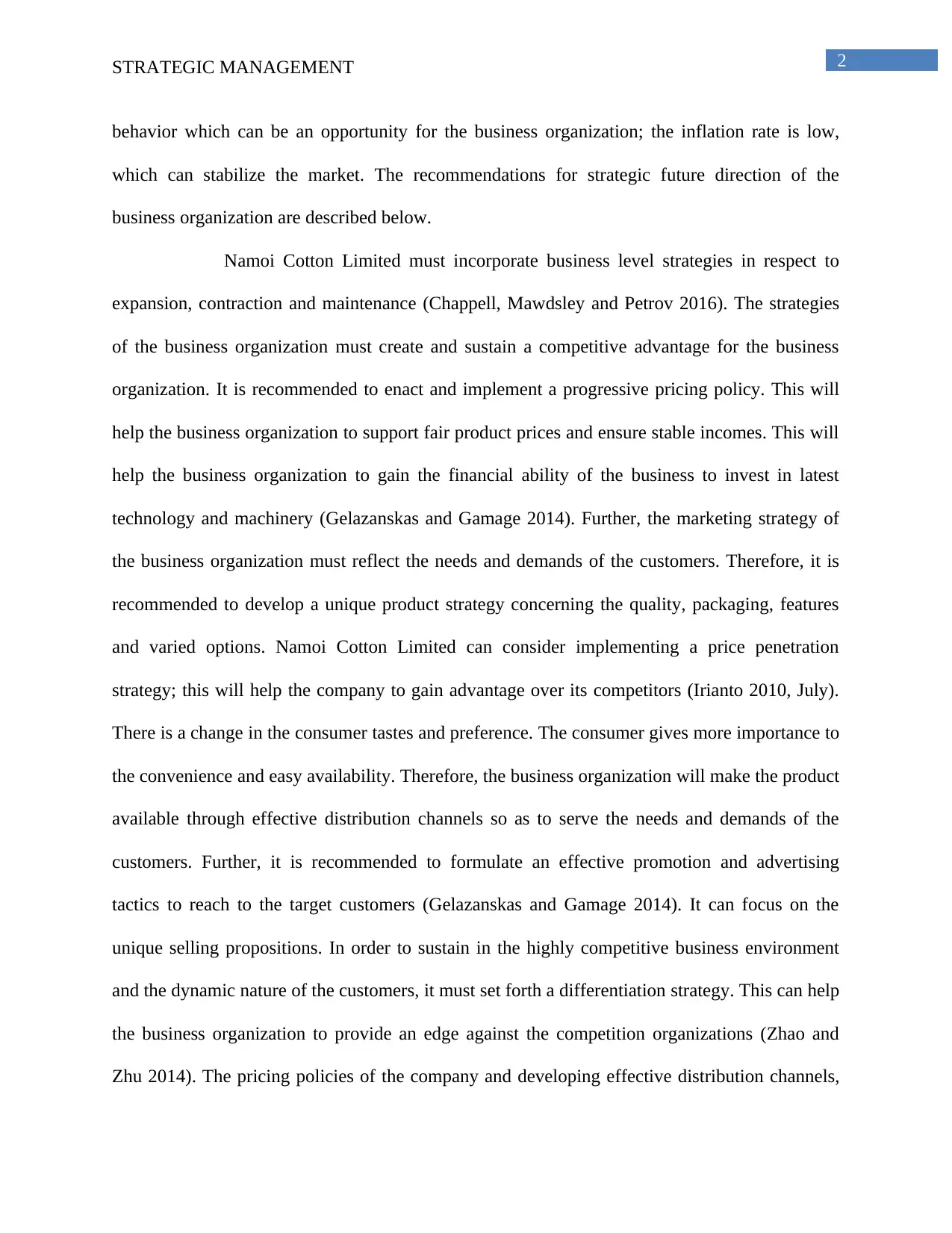
2STRATEGIC MANAGEMENT
behavior which can be an opportunity for the business organization; the inflation rate is low,
which can stabilize the market. The recommendations for strategic future direction of the
business organization are described below.
Namoi Cotton Limited must incorporate business level strategies in respect to
expansion, contraction and maintenance (Chappell, Mawdsley and Petrov 2016). The strategies
of the business organization must create and sustain a competitive advantage for the business
organization. It is recommended to enact and implement a progressive pricing policy. This will
help the business organization to support fair product prices and ensure stable incomes. This will
help the business organization to gain the financial ability of the business to invest in latest
technology and machinery (Gelazanskas and Gamage 2014). Further, the marketing strategy of
the business organization must reflect the needs and demands of the customers. Therefore, it is
recommended to develop a unique product strategy concerning the quality, packaging, features
and varied options. Namoi Cotton Limited can consider implementing a price penetration
strategy; this will help the company to gain advantage over its competitors (Irianto 2010, July).
There is a change in the consumer tastes and preference. The consumer gives more importance to
the convenience and easy availability. Therefore, the business organization will make the product
available through effective distribution channels so as to serve the needs and demands of the
customers. Further, it is recommended to formulate an effective promotion and advertising
tactics to reach to the target customers (Gelazanskas and Gamage 2014). It can focus on the
unique selling propositions. In order to sustain in the highly competitive business environment
and the dynamic nature of the customers, it must set forth a differentiation strategy. This can help
the business organization to provide an edge against the competition organizations (Zhao and
Zhu 2014). The pricing policies of the company and developing effective distribution channels,
behavior which can be an opportunity for the business organization; the inflation rate is low,
which can stabilize the market. The recommendations for strategic future direction of the
business organization are described below.
Namoi Cotton Limited must incorporate business level strategies in respect to
expansion, contraction and maintenance (Chappell, Mawdsley and Petrov 2016). The strategies
of the business organization must create and sustain a competitive advantage for the business
organization. It is recommended to enact and implement a progressive pricing policy. This will
help the business organization to support fair product prices and ensure stable incomes. This will
help the business organization to gain the financial ability of the business to invest in latest
technology and machinery (Gelazanskas and Gamage 2014). Further, the marketing strategy of
the business organization must reflect the needs and demands of the customers. Therefore, it is
recommended to develop a unique product strategy concerning the quality, packaging, features
and varied options. Namoi Cotton Limited can consider implementing a price penetration
strategy; this will help the company to gain advantage over its competitors (Irianto 2010, July).
There is a change in the consumer tastes and preference. The consumer gives more importance to
the convenience and easy availability. Therefore, the business organization will make the product
available through effective distribution channels so as to serve the needs and demands of the
customers. Further, it is recommended to formulate an effective promotion and advertising
tactics to reach to the target customers (Gelazanskas and Gamage 2014). It can focus on the
unique selling propositions. In order to sustain in the highly competitive business environment
and the dynamic nature of the customers, it must set forth a differentiation strategy. This can help
the business organization to provide an edge against the competition organizations (Zhao and
Zhu 2014). The pricing policies of the company and developing effective distribution channels,
⊘ This is a preview!⊘
Do you want full access?
Subscribe today to unlock all pages.

Trusted by 1+ million students worldwide
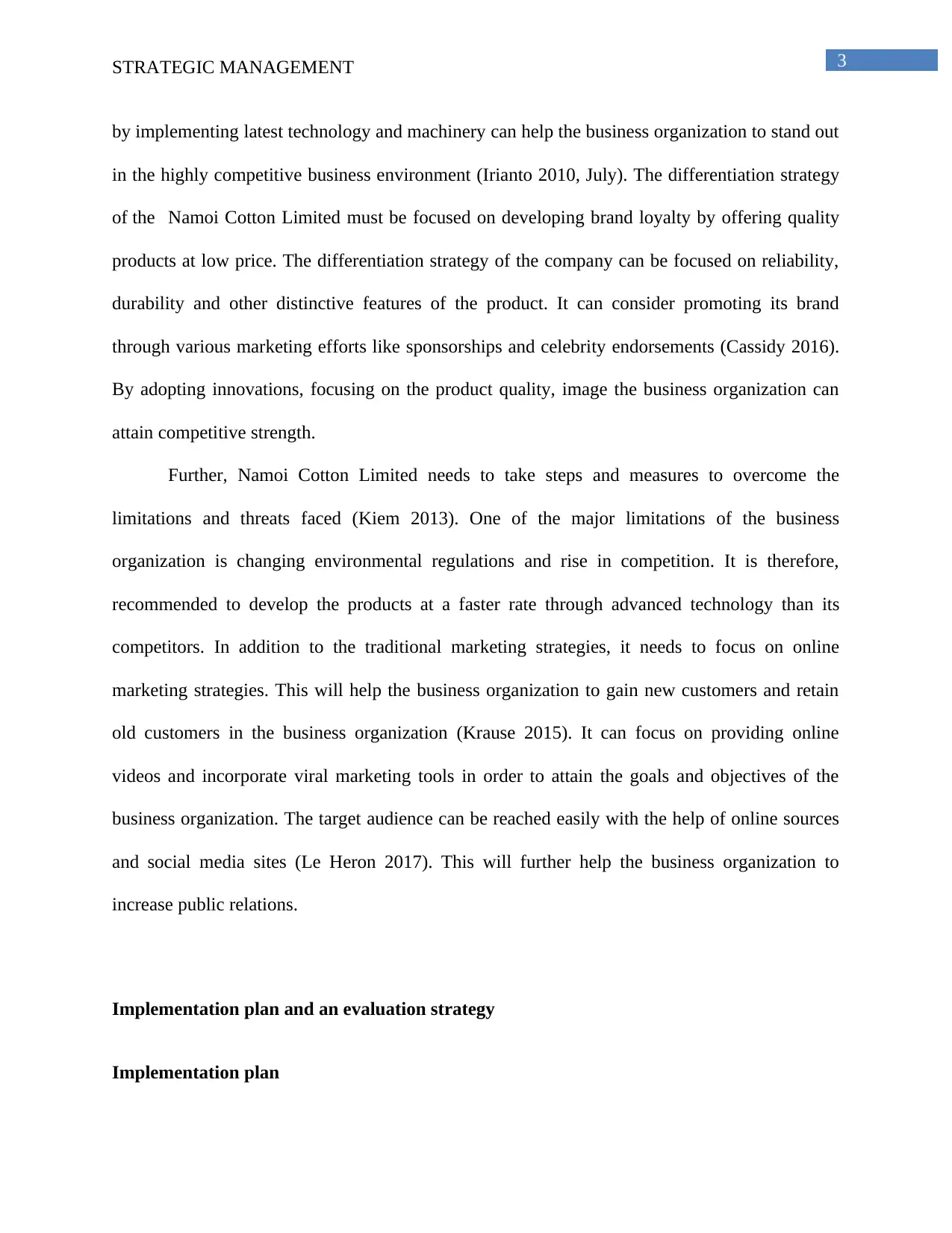
3STRATEGIC MANAGEMENT
by implementing latest technology and machinery can help the business organization to stand out
in the highly competitive business environment (Irianto 2010, July). The differentiation strategy
of the Namoi Cotton Limited must be focused on developing brand loyalty by offering quality
products at low price. The differentiation strategy of the company can be focused on reliability,
durability and other distinctive features of the product. It can consider promoting its brand
through various marketing efforts like sponsorships and celebrity endorsements (Cassidy 2016).
By adopting innovations, focusing on the product quality, image the business organization can
attain competitive strength.
Further, Namoi Cotton Limited needs to take steps and measures to overcome the
limitations and threats faced (Kiem 2013). One of the major limitations of the business
organization is changing environmental regulations and rise in competition. It is therefore,
recommended to develop the products at a faster rate through advanced technology than its
competitors. In addition to the traditional marketing strategies, it needs to focus on online
marketing strategies. This will help the business organization to gain new customers and retain
old customers in the business organization (Krause 2015). It can focus on providing online
videos and incorporate viral marketing tools in order to attain the goals and objectives of the
business organization. The target audience can be reached easily with the help of online sources
and social media sites (Le Heron 2017). This will further help the business organization to
increase public relations.
Implementation plan and an evaluation strategy
Implementation plan
by implementing latest technology and machinery can help the business organization to stand out
in the highly competitive business environment (Irianto 2010, July). The differentiation strategy
of the Namoi Cotton Limited must be focused on developing brand loyalty by offering quality
products at low price. The differentiation strategy of the company can be focused on reliability,
durability and other distinctive features of the product. It can consider promoting its brand
through various marketing efforts like sponsorships and celebrity endorsements (Cassidy 2016).
By adopting innovations, focusing on the product quality, image the business organization can
attain competitive strength.
Further, Namoi Cotton Limited needs to take steps and measures to overcome the
limitations and threats faced (Kiem 2013). One of the major limitations of the business
organization is changing environmental regulations and rise in competition. It is therefore,
recommended to develop the products at a faster rate through advanced technology than its
competitors. In addition to the traditional marketing strategies, it needs to focus on online
marketing strategies. This will help the business organization to gain new customers and retain
old customers in the business organization (Krause 2015). It can focus on providing online
videos and incorporate viral marketing tools in order to attain the goals and objectives of the
business organization. The target audience can be reached easily with the help of online sources
and social media sites (Le Heron 2017). This will further help the business organization to
increase public relations.
Implementation plan and an evaluation strategy
Implementation plan
Paraphrase This Document
Need a fresh take? Get an instant paraphrase of this document with our AI Paraphraser
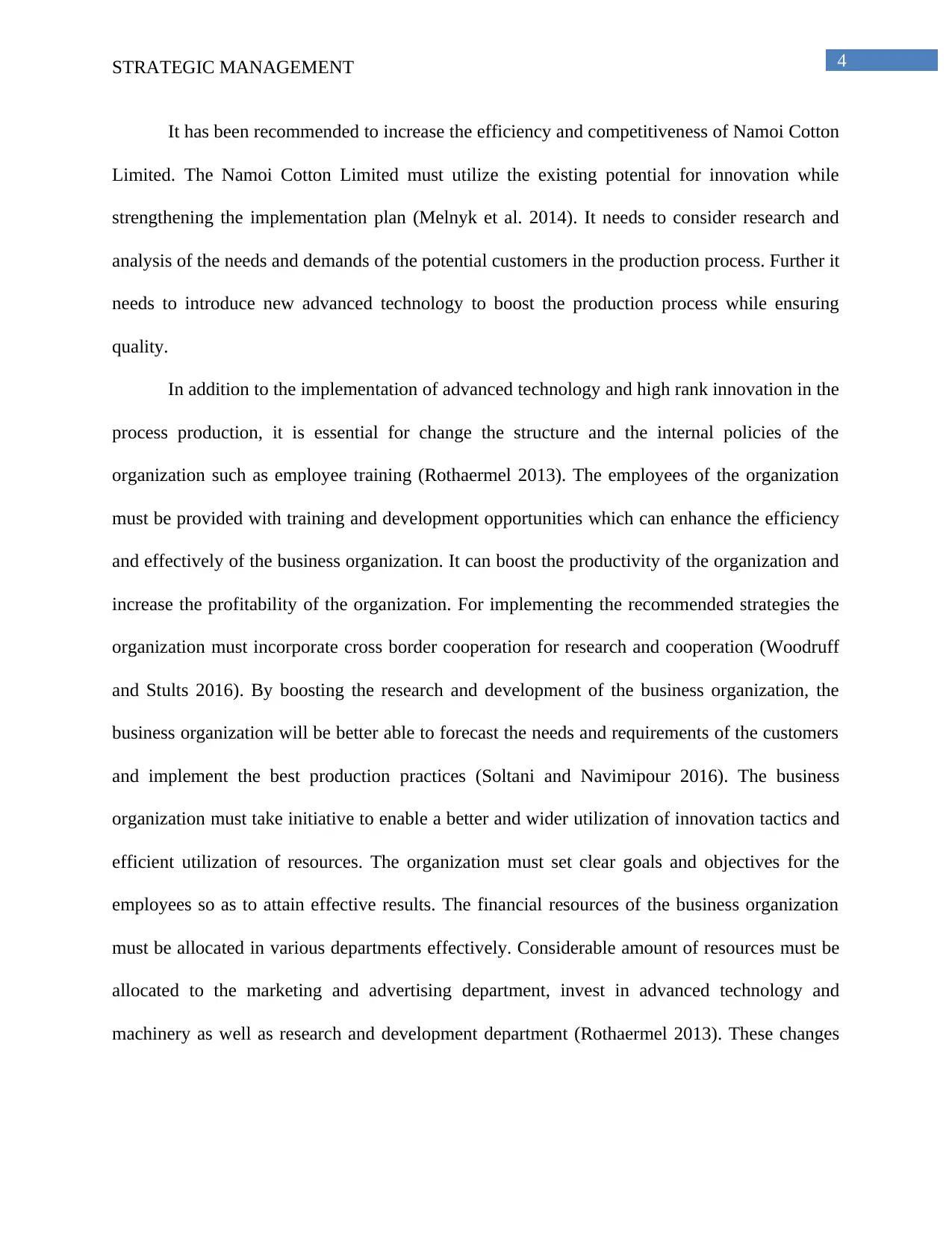
4STRATEGIC MANAGEMENT
It has been recommended to increase the efficiency and competitiveness of Namoi Cotton
Limited. The Namoi Cotton Limited must utilize the existing potential for innovation while
strengthening the implementation plan (Melnyk et al. 2014). It needs to consider research and
analysis of the needs and demands of the potential customers in the production process. Further it
needs to introduce new advanced technology to boost the production process while ensuring
quality.
In addition to the implementation of advanced technology and high rank innovation in the
process production, it is essential for change the structure and the internal policies of the
organization such as employee training (Rothaermel 2013). The employees of the organization
must be provided with training and development opportunities which can enhance the efficiency
and effectively of the business organization. It can boost the productivity of the organization and
increase the profitability of the organization. For implementing the recommended strategies the
organization must incorporate cross border cooperation for research and cooperation (Woodruff
and Stults 2016). By boosting the research and development of the business organization, the
business organization will be better able to forecast the needs and requirements of the customers
and implement the best production practices (Soltani and Navimipour 2016). The business
organization must take initiative to enable a better and wider utilization of innovation tactics and
efficient utilization of resources. The organization must set clear goals and objectives for the
employees so as to attain effective results. The financial resources of the business organization
must be allocated in various departments effectively. Considerable amount of resources must be
allocated to the marketing and advertising department, invest in advanced technology and
machinery as well as research and development department (Rothaermel 2013). These changes
It has been recommended to increase the efficiency and competitiveness of Namoi Cotton
Limited. The Namoi Cotton Limited must utilize the existing potential for innovation while
strengthening the implementation plan (Melnyk et al. 2014). It needs to consider research and
analysis of the needs and demands of the potential customers in the production process. Further it
needs to introduce new advanced technology to boost the production process while ensuring
quality.
In addition to the implementation of advanced technology and high rank innovation in the
process production, it is essential for change the structure and the internal policies of the
organization such as employee training (Rothaermel 2013). The employees of the organization
must be provided with training and development opportunities which can enhance the efficiency
and effectively of the business organization. It can boost the productivity of the organization and
increase the profitability of the organization. For implementing the recommended strategies the
organization must incorporate cross border cooperation for research and cooperation (Woodruff
and Stults 2016). By boosting the research and development of the business organization, the
business organization will be better able to forecast the needs and requirements of the customers
and implement the best production practices (Soltani and Navimipour 2016). The business
organization must take initiative to enable a better and wider utilization of innovation tactics and
efficient utilization of resources. The organization must set clear goals and objectives for the
employees so as to attain effective results. The financial resources of the business organization
must be allocated in various departments effectively. Considerable amount of resources must be
allocated to the marketing and advertising department, invest in advanced technology and
machinery as well as research and development department (Rothaermel 2013). These changes
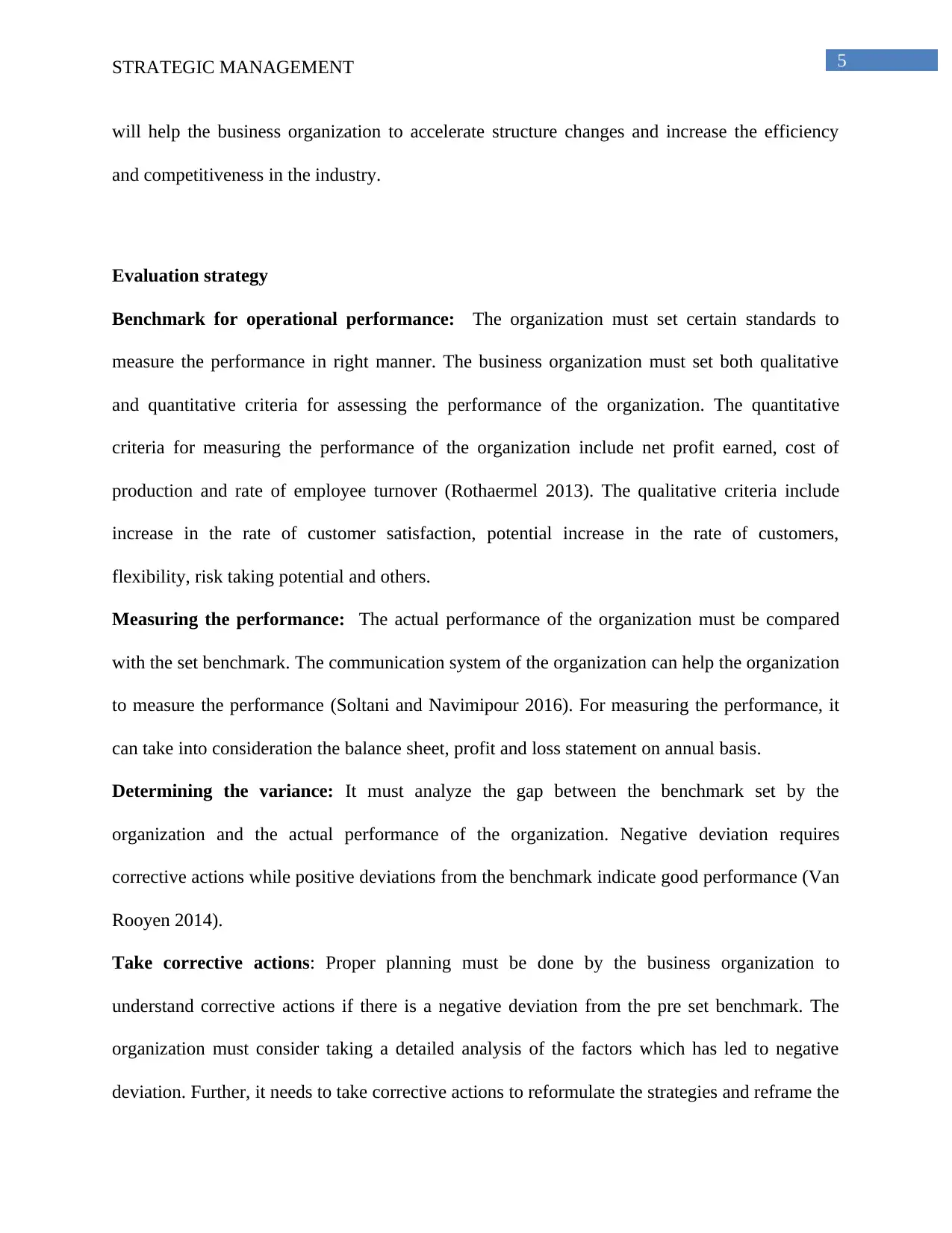
5STRATEGIC MANAGEMENT
will help the business organization to accelerate structure changes and increase the efficiency
and competitiveness in the industry.
Evaluation strategy
Benchmark for operational performance: The organization must set certain standards to
measure the performance in right manner. The business organization must set both qualitative
and quantitative criteria for assessing the performance of the organization. The quantitative
criteria for measuring the performance of the organization include net profit earned, cost of
production and rate of employee turnover (Rothaermel 2013). The qualitative criteria include
increase in the rate of customer satisfaction, potential increase in the rate of customers,
flexibility, risk taking potential and others.
Measuring the performance: The actual performance of the organization must be compared
with the set benchmark. The communication system of the organization can help the organization
to measure the performance (Soltani and Navimipour 2016). For measuring the performance, it
can take into consideration the balance sheet, profit and loss statement on annual basis.
Determining the variance: It must analyze the gap between the benchmark set by the
organization and the actual performance of the organization. Negative deviation requires
corrective actions while positive deviations from the benchmark indicate good performance (Van
Rooyen 2014).
Take corrective actions: Proper planning must be done by the business organization to
understand corrective actions if there is a negative deviation from the pre set benchmark. The
organization must consider taking a detailed analysis of the factors which has led to negative
deviation. Further, it needs to take corrective actions to reformulate the strategies and reframe the
will help the business organization to accelerate structure changes and increase the efficiency
and competitiveness in the industry.
Evaluation strategy
Benchmark for operational performance: The organization must set certain standards to
measure the performance in right manner. The business organization must set both qualitative
and quantitative criteria for assessing the performance of the organization. The quantitative
criteria for measuring the performance of the organization include net profit earned, cost of
production and rate of employee turnover (Rothaermel 2013). The qualitative criteria include
increase in the rate of customer satisfaction, potential increase in the rate of customers,
flexibility, risk taking potential and others.
Measuring the performance: The actual performance of the organization must be compared
with the set benchmark. The communication system of the organization can help the organization
to measure the performance (Soltani and Navimipour 2016). For measuring the performance, it
can take into consideration the balance sheet, profit and loss statement on annual basis.
Determining the variance: It must analyze the gap between the benchmark set by the
organization and the actual performance of the organization. Negative deviation requires
corrective actions while positive deviations from the benchmark indicate good performance (Van
Rooyen 2014).
Take corrective actions: Proper planning must be done by the business organization to
understand corrective actions if there is a negative deviation from the pre set benchmark. The
organization must consider taking a detailed analysis of the factors which has led to negative
deviation. Further, it needs to take corrective actions to reformulate the strategies and reframe the
⊘ This is a preview!⊘
Do you want full access?
Subscribe today to unlock all pages.

Trusted by 1+ million students worldwide
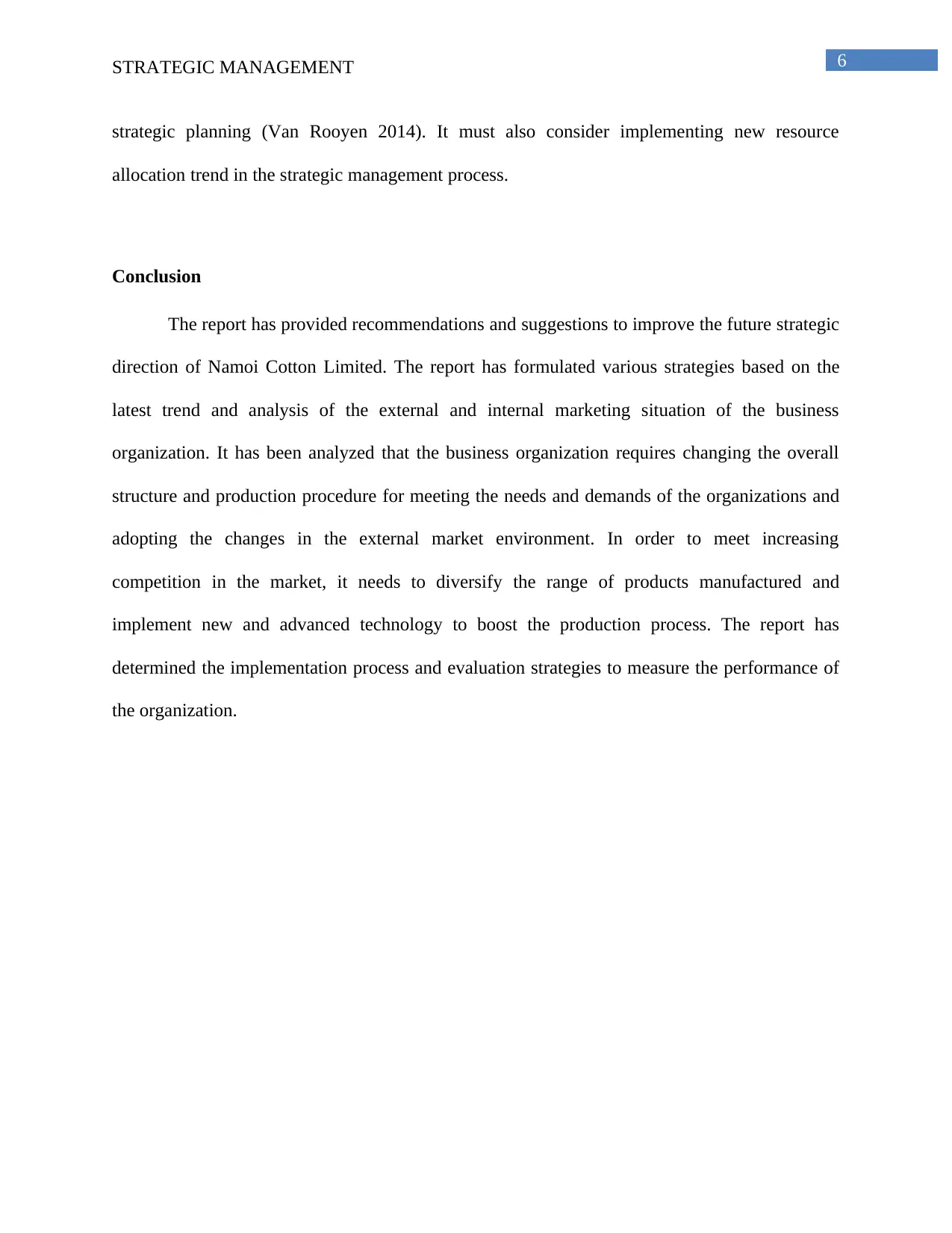
6STRATEGIC MANAGEMENT
strategic planning (Van Rooyen 2014). It must also consider implementing new resource
allocation trend in the strategic management process.
Conclusion
The report has provided recommendations and suggestions to improve the future strategic
direction of Namoi Cotton Limited. The report has formulated various strategies based on the
latest trend and analysis of the external and internal marketing situation of the business
organization. It has been analyzed that the business organization requires changing the overall
structure and production procedure for meeting the needs and demands of the organizations and
adopting the changes in the external market environment. In order to meet increasing
competition in the market, it needs to diversify the range of products manufactured and
implement new and advanced technology to boost the production process. The report has
determined the implementation process and evaluation strategies to measure the performance of
the organization.
strategic planning (Van Rooyen 2014). It must also consider implementing new resource
allocation trend in the strategic management process.
Conclusion
The report has provided recommendations and suggestions to improve the future strategic
direction of Namoi Cotton Limited. The report has formulated various strategies based on the
latest trend and analysis of the external and internal marketing situation of the business
organization. It has been analyzed that the business organization requires changing the overall
structure and production procedure for meeting the needs and demands of the organizations and
adopting the changes in the external market environment. In order to meet increasing
competition in the market, it needs to diversify the range of products manufactured and
implement new and advanced technology to boost the production process. The report has
determined the implementation process and evaluation strategies to measure the performance of
the organization.
Paraphrase This Document
Need a fresh take? Get an instant paraphrase of this document with our AI Paraphraser
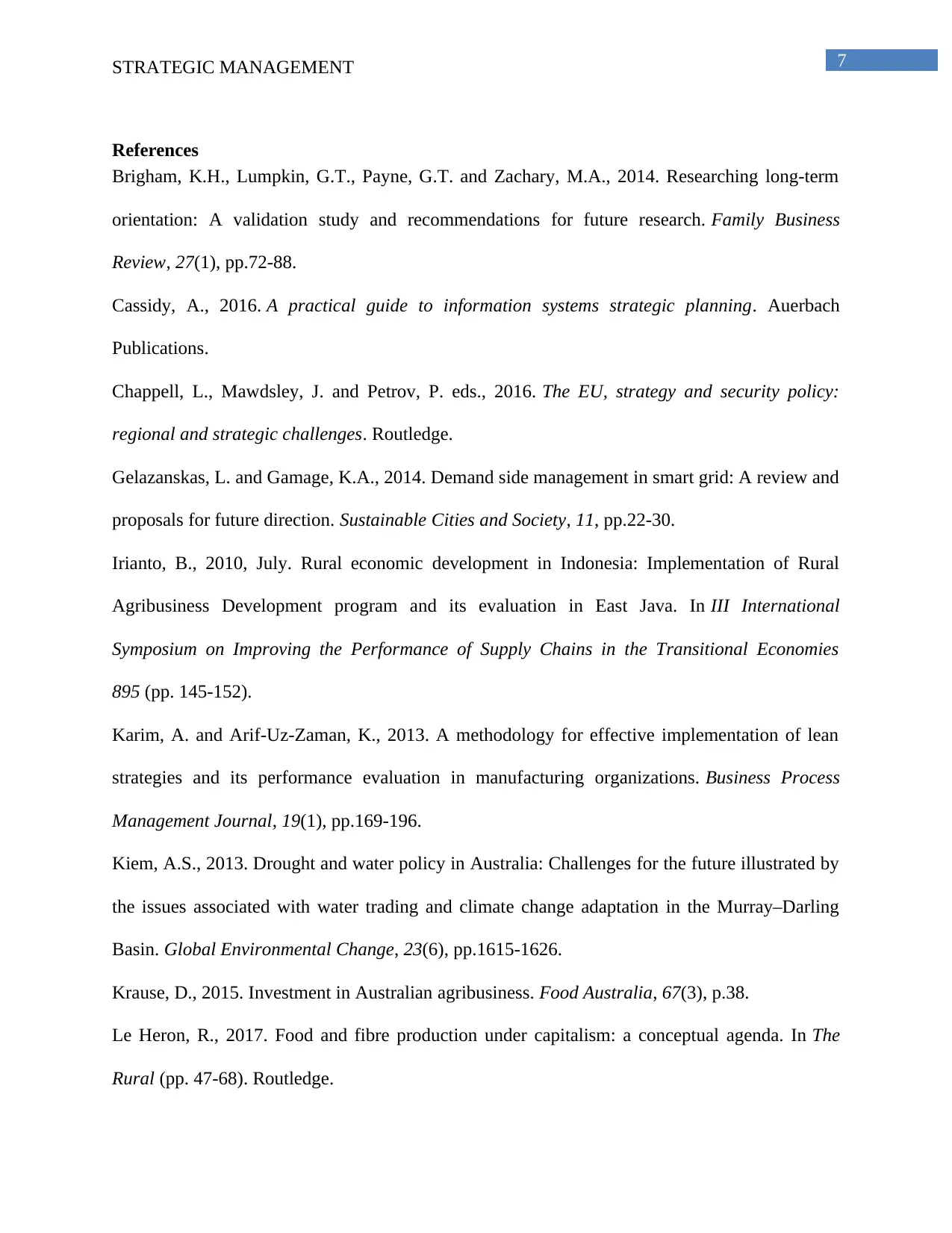
7STRATEGIC MANAGEMENT
References
Brigham, K.H., Lumpkin, G.T., Payne, G.T. and Zachary, M.A., 2014. Researching long-term
orientation: A validation study and recommendations for future research. Family Business
Review, 27(1), pp.72-88.
Cassidy, A., 2016. A practical guide to information systems strategic planning. Auerbach
Publications.
Chappell, L., Mawdsley, J. and Petrov, P. eds., 2016. The EU, strategy and security policy:
regional and strategic challenges. Routledge.
Gelazanskas, L. and Gamage, K.A., 2014. Demand side management in smart grid: A review and
proposals for future direction. Sustainable Cities and Society, 11, pp.22-30.
Irianto, B., 2010, July. Rural economic development in Indonesia: Implementation of Rural
Agribusiness Development program and its evaluation in East Java. In III International
Symposium on Improving the Performance of Supply Chains in the Transitional Economies
895 (pp. 145-152).
Karim, A. and Arif-Uz-Zaman, K., 2013. A methodology for effective implementation of lean
strategies and its performance evaluation in manufacturing organizations. Business Process
Management Journal, 19(1), pp.169-196.
Kiem, A.S., 2013. Drought and water policy in Australia: Challenges for the future illustrated by
the issues associated with water trading and climate change adaptation in the Murray–Darling
Basin. Global Environmental Change, 23(6), pp.1615-1626.
Krause, D., 2015. Investment in Australian agribusiness. Food Australia, 67(3), p.38.
Le Heron, R., 2017. Food and fibre production under capitalism: a conceptual agenda. In The
Rural (pp. 47-68). Routledge.
References
Brigham, K.H., Lumpkin, G.T., Payne, G.T. and Zachary, M.A., 2014. Researching long-term
orientation: A validation study and recommendations for future research. Family Business
Review, 27(1), pp.72-88.
Cassidy, A., 2016. A practical guide to information systems strategic planning. Auerbach
Publications.
Chappell, L., Mawdsley, J. and Petrov, P. eds., 2016. The EU, strategy and security policy:
regional and strategic challenges. Routledge.
Gelazanskas, L. and Gamage, K.A., 2014. Demand side management in smart grid: A review and
proposals for future direction. Sustainable Cities and Society, 11, pp.22-30.
Irianto, B., 2010, July. Rural economic development in Indonesia: Implementation of Rural
Agribusiness Development program and its evaluation in East Java. In III International
Symposium on Improving the Performance of Supply Chains in the Transitional Economies
895 (pp. 145-152).
Karim, A. and Arif-Uz-Zaman, K., 2013. A methodology for effective implementation of lean
strategies and its performance evaluation in manufacturing organizations. Business Process
Management Journal, 19(1), pp.169-196.
Kiem, A.S., 2013. Drought and water policy in Australia: Challenges for the future illustrated by
the issues associated with water trading and climate change adaptation in the Murray–Darling
Basin. Global Environmental Change, 23(6), pp.1615-1626.
Krause, D., 2015. Investment in Australian agribusiness. Food Australia, 67(3), p.38.
Le Heron, R., 2017. Food and fibre production under capitalism: a conceptual agenda. In The
Rural (pp. 47-68). Routledge.
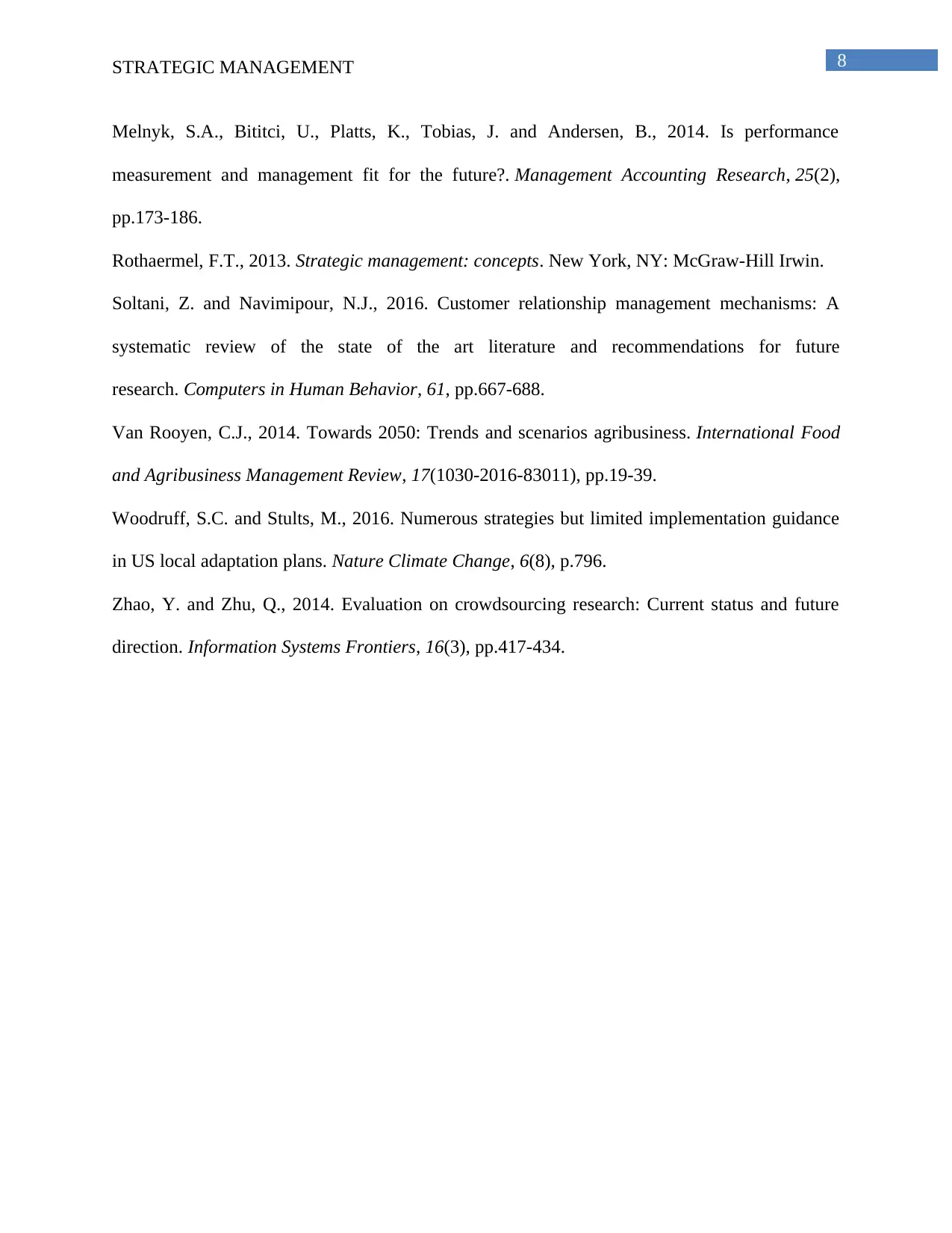
8STRATEGIC MANAGEMENT
Melnyk, S.A., Bititci, U., Platts, K., Tobias, J. and Andersen, B., 2014. Is performance
measurement and management fit for the future?. Management Accounting Research, 25(2),
pp.173-186.
Rothaermel, F.T., 2013. Strategic management: concepts. New York, NY: McGraw-Hill Irwin.
Soltani, Z. and Navimipour, N.J., 2016. Customer relationship management mechanisms: A
systematic review of the state of the art literature and recommendations for future
research. Computers in Human Behavior, 61, pp.667-688.
Van Rooyen, C.J., 2014. Towards 2050: Trends and scenarios agribusiness. International Food
and Agribusiness Management Review, 17(1030-2016-83011), pp.19-39.
Woodruff, S.C. and Stults, M., 2016. Numerous strategies but limited implementation guidance
in US local adaptation plans. Nature Climate Change, 6(8), p.796.
Zhao, Y. and Zhu, Q., 2014. Evaluation on crowdsourcing research: Current status and future
direction. Information Systems Frontiers, 16(3), pp.417-434.
Melnyk, S.A., Bititci, U., Platts, K., Tobias, J. and Andersen, B., 2014. Is performance
measurement and management fit for the future?. Management Accounting Research, 25(2),
pp.173-186.
Rothaermel, F.T., 2013. Strategic management: concepts. New York, NY: McGraw-Hill Irwin.
Soltani, Z. and Navimipour, N.J., 2016. Customer relationship management mechanisms: A
systematic review of the state of the art literature and recommendations for future
research. Computers in Human Behavior, 61, pp.667-688.
Van Rooyen, C.J., 2014. Towards 2050: Trends and scenarios agribusiness. International Food
and Agribusiness Management Review, 17(1030-2016-83011), pp.19-39.
Woodruff, S.C. and Stults, M., 2016. Numerous strategies but limited implementation guidance
in US local adaptation plans. Nature Climate Change, 6(8), p.796.
Zhao, Y. and Zhu, Q., 2014. Evaluation on crowdsourcing research: Current status and future
direction. Information Systems Frontiers, 16(3), pp.417-434.
⊘ This is a preview!⊘
Do you want full access?
Subscribe today to unlock all pages.

Trusted by 1+ million students worldwide
1 out of 9
Related Documents
Your All-in-One AI-Powered Toolkit for Academic Success.
+13062052269
info@desklib.com
Available 24*7 on WhatsApp / Email
![[object Object]](/_next/static/media/star-bottom.7253800d.svg)
Unlock your academic potential
Copyright © 2020–2025 A2Z Services. All Rights Reserved. Developed and managed by ZUCOL.





